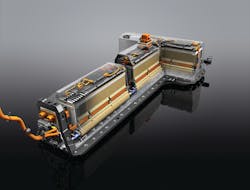SUBJECT: High-Voltage Lithium-Ion Vehicle Batteries
TOPIC: Thermal Events
OBJECTIVE: Upon the conclusion of this series, the fire service responder will have a better understanding of the thermal events that can and have occurred involving liquid-cooled, high-voltage batteries at vehicle collision or fire-related incidents. (Note: There have been no vehicle fires as a result of real-world crashes involving electric vehicles.)
TASK: Upon the conclusion of this series, fire service responders shall be able to develop department guidelines for dealing with liquid-cooled, high-voltage batteries at a vehicle collision or fire-related incident.
This University of Extrication multi-part series comes right from the headlines of today’s newspapers. The topic being addressed is what is called “thermal events” involving liquid-cooled, high-voltage, lithium-ion batteries. Specifically, the Chevrolet VOLT extended-range, plug-in electric vehicle has come under close scrutiny because the VOLT’s battery was either a point of fire origin or an innocent victim in a series of fire situations that began occurring as early as May 2011 across the U.S. In two separate structure fire incidents, a Volt was parked in a garage that burned. In three other instances, the high-voltage battery from a Volt was damaged during government testing and experienced a thermal event.
Now that the smoke has literally cleared and the investigations and research are winding down, it’s time for fire service responders to understand what actually happened at these VOLT battery fires and how these incidents show us that changes in our current on-scene procedures as well as our training for hybrid or electric plug-in vehicles at incident scenes will be necessary.
The Chevrolet VOLT is the car that has been looked at most closely by government agencies, the news media and the public recently. It is therefore the vehicle that is discussed in this series of University of Extrication columns. It is not, however, the only vehicle on the road today that uses this one particular type of high-voltage battery system.
Use in hybrid vehicles
Gasoline-electric hybrid vehicles, the ones that we as responders are most familiar with, use high-voltage batteries as a component of their operating system. Originally, these hybrid vehicle batteries were all of the nickel-metal hydride type, beginning with the original Honda Insight and the first-generation Toyota Prius. In these early years, responders studied the variety of hybrid vehicle emergency guidelines and became comfortable with how to deal with these vehicles in collision or fire incidents. After 10 years and hundreds of thousands of hybrids being produced and sold, when the 2011 model-year vehicles rolled out, a new classification of vehicle appeared that introduced a new challenge for responders: the electric plug-in vehicle.
The Nissan LEAF and the Chevrolet VOLT are on the streets today and throughout the first year of their existence, firefighters across the country trained on these vehicles through national programs such as the National Fire Protection Association (NFPA) Electric Vehicle Safety Training classes. We all thought we had them figured out. Then suddenly, “thermal events” with the Chevrolet VOLT battery were reported due to physical damage to the lithium-ion, 360-volt battery that have resulted in recommended new guidelines that differ slightly from what we originally believed were appropriate electric-vehicle protocols.
New chemistry
Both the LEAF and the VOLT use large, high-voltage batteries to power their vehicles, but instead of being of the familiar nickel-metal hydride chemistry, these new vehicles contain lithium-ion chemistry batteries. This new chemistry gives the automaker a longer-duration battery; consider it a battery that holds a longer-lasting charge.
One important requirement for getting the best performance out of the new-generation lithium-ion battery is that the cells of the battery must be maintained within a specified temperature range – not too hot and not too cold. To cool the battery in the LEAF, Nissan designed an air-cooled battery system. Chevrolet, on the other hand, designed its lithium-ion battery to be cooled with liquid. The liquid that circulates within the battery enclosure on the VOLT is ethylene glycol – essentially 6.3 quarts of antifreeze.
Before we can understand these “thermal events” that occurred, we must first understand how the VOLT’s battery is designed and constructed. To do that, we will use an artist’s rendering of a cutaway VOLT battery.
As we explain the layout of the battery, refer to the image to see exactly what we are talking about. The VOLT’s 400-pound battery is T-shaped and fits beneath the floorpan along the center tunnel and below the rear seats. When discussing the battery, this author frequently refers to its design as a “loaf of bread.” The cells of the battery are like slices of bread, and when set together with their connecting wires, they form the “loaf of bread.” The cells that are visible in this rendering are held in place with plastic frames called “repeater frames.” The VOLT battery consists of several of these connected modules, all within one big battery enclosure.
It has been mentioned that the VOLT battery is liquid cooled. What is critical for responders to understand from this rendering is that between each of the narrow lithium-ion cells are even thinner plates called “thermal fins.” These paper-thin, tin foil-looking fins are what cools the VOLT battery’s lithium-ion cells. To accomplish this, each fin has liquid lines running through it. The antifreeze solution enters the VOLT battery at the front end and circulates through the repeater frames, tubing, hose connections and all of these thermal fins. Entering as cool solution and exiting as warmed coolant, the system maintains optimum temperature for the lithium-ion cells to function as designed. The radiator is under the hood at the front of the vehicle.
Location and design
The second point that must be gained from this cutaway image is the location of the battery’s electrical components. In the VOLT design, all wiring, connectors and terminals run along the very top of the repeater frames. Like the liquid coolant, the high-voltage current flows in through one orange connector at the front of the battery and runs through all 288 cells. The 360-volt DC current flows out of the battery through a different orange connector at the front of the battery.
Now that you have a better understanding of the design of the VOLT battery, in Part 2 we will look at the 2011 fire incidents where a Chevrolet VOLT was present and explain what investigators determined happened in each case.
TASK: Upon the conclusion of this series, fire service responders shall be able to develop department guidelines for dealing with liquid-cooled, high-voltage batteries at a vehicle collision or fire-related incident.
Read the rest of the series here:






